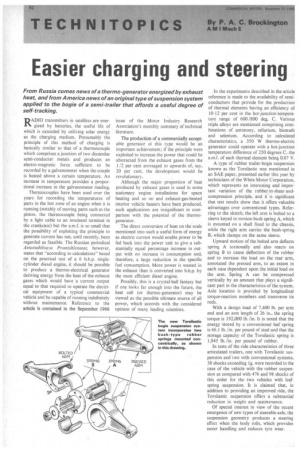Easier charging and steering
Page 64

If you've noticed an error in this article please click here to report it so we can fix it.
From Russia comes news of a thermo-generator energized by exhaust heat, and from America news of an original type of suspension system applied to the bogie of a semi-trailer that affords a useful degree of self-tracking.
RADIO transmitters in satellites are energized by batteries, the useful life of which is extended by utilizing solar energy as the charging medium. Presumably the principle of this method of charging is basically similar to that of a thermocouple which comprises a junction of two dissimilar semi-conducter metals and produces an electro-magnetic force sufficient to be recorded by a galvanometer when the couple is heated above a certain temperature. An increase in temperature provides a proportional increase in the galvanometer reading.
Thermocouples have been used over the years for recording the temperatures of parts in the hot zone of an engine when it is running (notably of moving parts such as the piston, the thermocouple being connected by a light cable to an insulated terminal in the crankcase) but the e.m.f. is so small that the possibility of exploiting the principle to generate current has not, until recently, been regarded as feasible. The Russian periodical Avtomobilnaya Promishlennost, however, states that "according to calculations" based on the practical test of a 6 b.h.p. singlecylinder diesel engine, it should be possible to produce a thermo-electrical generator deriving energy from the heat of the exhaust gases which would have "a current output equal to that required to operate the electrical equipment of a typical commercial vehicle and be capable of running indefinitely without maintenance. Reference to the article is contained in the September 1966 issue of the Motor Industry Research Association's monthly summary of technical literature.
The production of a commercially acceptable generator of this type would be an important achievement; if the principle were exploited to increase the power that could be abstracted from the exhaust gases from the 1/2 per cent envisaged to upwards of, say, 20 per cent, the development would be revolutionary.
Although the major proportion of heat produced by exhaust gases is used in some stationary engine installations for space heating and so on and exhaust-gas-heated interior vehicle heaters have been produced, such applications are insignificant in comparison with the potential of the thermo generator.
The direct conversion of heat on the scale mentioned into such a useful form of energy as electric current would enable power to be fed back into the power unit to give a substantially equal percentage increase in output with no increase in consumption and, therefore, a large reduction in the specific fuel consumption. More power is wasted in the exhaust than is converted into b.h.p. by the most efficient diesel engine.
Possibly, this is a crystal-ball fantasy but if one looks far enough into the future, the heat cell (or thermo-generator) may be viewed as the possible ultimate source of all power, which accords with the considered opinion of many leading scientists. In the experiments described in the article reference is made to the availability of semiconductors that provide for the production of thermal elements having an efficiency of 10-12 per cent in the hot-junction-temperature range of 600/800 deg. C. Various triple alloys are mentioned comprising combinations of antimony, tellurium, bismuth and selenium. According to calculated characteristics, a 350 W thermo-electric generator could operate with a hot-junction temperature difference of 250 degrees C, the e.m.f. of each thermal element being 0.07 V.
A type of rubber trailer-bogie suspension known as the Torsilastic was mentioned in an SAE paper, presented earlier this year by technicians of the White Motor Corporation, which represents an interesting and important variation of the rubber-in-shear-andcompression principle, and it is significant that test results show that it offers valuable advantages over conventional types. Referring to the sketch, the left arm is bolted to a sleeve keyed to torsion-bush spring A, which is mounted on a shaft fixed to the chassis, while the right arm carries the bush-spring B, which clamps on the same sleeve.
Upward motion of the bolted arm deflects spring A torsionally and also reacts on spring B to cause deflection of the rubber and to increase the load on the rear arm, annotated the pressed arm, to an extent in each case dependent upon the initial load on the arm. Spring A can be compressed vertically by an amount that plays a significant part in the characteristics of the system. Axle location is provided by longitudinal torque-reaction members and transverse tie rods.
With a design load of 7,400 lb. per arm end and an arm length of 26 in., the spring torque is 192,000 lb. /in. It is noted that the energy stored by a conventional leaf spring is 66.1 lb. /in. per pound of steel and that the storage capacity of the Torsilastic spring is 1,945 lb./in. per pound of rubber.
In tests of the ride characteristics of three articulated trailers, one with Torsilastic suspension and' two with conventional systems, 38 shocks exceeding lg. were recorded in the case of the vehicle with the rubber suspension as compared with 476 and 98 shocks of this order for the two vehicles with leafspring suspension. It is claimed that, in addition to providing an improved ride, the Torsilastic suspension offers a substantial reduction in weight and maintenance.
Of special interest in view of the recent emergence of new types of steerable axle, the suspension geometry produces a steering effect when the body rolls, which provides easier handling and reduces tyre wear.












































































































